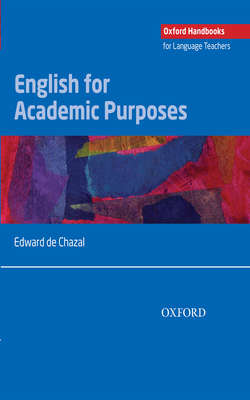Читать книгу English for Academic Purposes - Edward de Chazal - Страница 5
На сайте Литреса книга снята с продажи.
INTRODUCTION
ОглавлениеBackground and context
When I started teaching English as a Foreign Language (EFL) in 1987, the teaching certificate I did in London had a short session on English for specific purposes (ESP), but no mention was made of English for academic purposes (EAP). It probably took a year or two before I ever heard about EAP. In the context of my teaching certificate at International House London, ESP meant business English. Business students, we were told, are motivated, and have interesting lives involving travel. Our trainers also said that in order to teach business English, we would need technical language, and also to be interested in business. My trainee notes, well saved, also reveal that, in ESP, fluency is more important than accuracy, and finally that ‘if you’re not interested in ESP, don’t touch it with a barge pole’.
How far these observations hold true today, if they did indeed hold true then, can remain a matter for discussion. For teachers starting to teach EAP, some of whom will have taught business English, and nearly all of whom will have their own experiences of studying in higher or further education, there are likely to be different concerns: How do I go about teaching EAP? Should I use different techniques and methodologies to those in business and general English contexts? Where can I find good materials? What do my students expect of me? How will I cope with the demands of an intensive pre-sessional programme? Which aspects of language should I prioritize? What can I do to improve my students’ writing and speaking? What exactly is EAP anyway?
This book is written for these teachers, and indeed all teachers of EAP worldwide, and aims to address questions such as these. It introduces and defines the field of EAP and offers many practical applications of the theories and ideas which are currently in circulation. EAP teachers at all levels of experience can benefit from the ideas and approaches presented. As with academic textbooks in general, the material in this book is presented to be interpreted, applied, and critiqued. Above all, this book is written to be purposeful and relevant to the needs of EAP teachers working in a wide variety of contexts around the world.
Purpose and organization
This book aims to give EAP teachers at all levels of experience a comprehensive, up to date, and coherent account of the field of English for academic purposes, offering an accessible description of EAP practice, which is thoroughly grounded in current theories and developments in the field.
Chapter 1 opens the discussion by setting out ‘The field of EAP’, which is seen as a research-informed practice influenced by many theoretical and practical approaches over a period of more than half a century. Chapter 2, ‘Teaching and learning’, presents a context in which EAP students can be seen as resources of knowledge and experience rather than deficient students in need of remedial training. This chapter discusses teacher competences and current issues in EAP teaching and methodology. In Chapter 3, ‘Texts’, academic texts are presented as sources of knowledge and argument, and are described and analysed to emphasize their meaning and use for EAP teaching and learning. Chapter 4, ‘Language’, casts academic language as agent of meaning: it is through reusable language forms and patterns that original, complex, and abstract meanings can be expressed. This chapter argues for an inclusive approach to language analysis and teaching which recognizes the fundamental inseparability of vocabulary and grammar. Chapter 5, ‘Critical thinking’, sees the critical thinker as reflector and challenger. Critical thinking is essential in academic contexts, and starts with the practice of reflecting on the meanings expressed in texts, and the wider context of the texts themselves.
Opening a sequence of chapters covering the four skills, Chapter 6, ‘Reading’, explores the role of the academic reader as processor and evaluator. Academic reading is purposeful and productive, and by emphasizing these processing and evaluating roles, EAP teachers can develop their students’ efficiency in reading and processing the information for their own use. This material leads to Chapter 7, ‘Writing’, in which the academic writer is cast as architect of meaning. Based on their reading and thinking, academic writers carry out multiple roles, including assembling and constructing a meaningful new text and managing the writing project. Chapter 8, ‘Listening’, highlights the role of the academic listener as interpreter and recorder through their work in decoding spoken texts and noting down meanings. Chapter 9, ‘Speaking’, consolidates the sequence of chapters on skills by illustrating the academic speaker as reporter and persuader, particularly using material they have read, listened to, and critiqued.
Following this sequence of skills-focused chapters, Chapter 10, ‘Materials’, looks at principled ways of using, evaluating, and writing materials which reflect the position of EAP teachers in relation to the influences presented in Chapter 1, the issues discussed in Chapter 2, and the series of approaches described in this chapter. EAP materials are seen as objective-driven tasks leading to independence, since student independence is an ultimate aim of EAP. Chapter 11, ‘Assessment’, considers the roles and types of assessments in EAP, showing assessments as tools to determine students’ academic progression through the EAP programme and into their chosen discipline. Finally, Chapter 12, ‘Technologies’, positions technologies as resources for communication and learning. By maximizing the use of the available technologies, EAP teachers and students can enhance the effectiveness of their teaching and learning.
The final part of the book offers a conclusion to briefly sum up the main arguments in the book as a whole, a glossary of terms used, a bibliography of works cited in the text, and an index.
